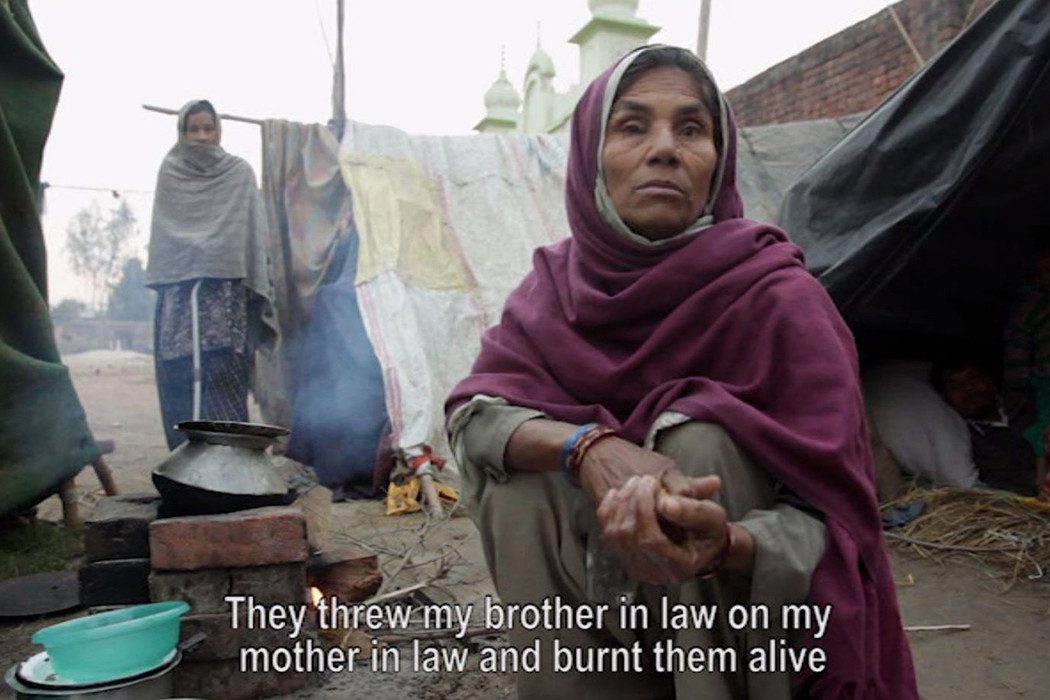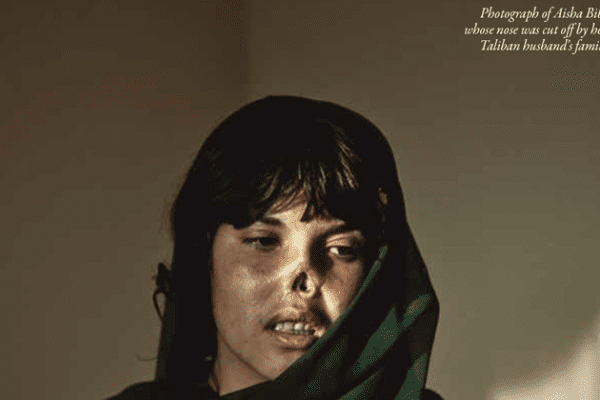Nakul Singh Sawhney’s insightful documentary on the Muzaffarnagar riots is an essential reminder of the human costs of communal polarisation, says Ajachi Chakrabarti.
Is baar danga bahut bada tha
Khoob hui thi khoon ki baarish
Agle saal achchhi hogi fasal
Matdaan ki
(This time the riot was very big
There was a heavy rain of blood
Next year, there will be an abundant harvest
Of votes)
The epigraph to Nakul Singh Sawhney’s Muzaffarnagar Baaqi Hai, by the revolutionary poet Gorakh Pandey, is a chilling indictment of the politics of communal polarisation. Over the course of the film’s 136-minute runtime, as you watch the cynical tactics of the Sangh Parivar play out, vitiating the atmosphere in a region whose Hindu-Muslim amity caused it to once be called Mohabbatnagar, the truth of Pandey’s assertion becomes all too real.
The assertion, which might seem like a poet’s hyperbole, is backed by data; a study last year by three political scientists from Yale found that “the BJS/BJP saw a 0.8 percentage point increase in their vote share following a riot in the year prior to an election.” In case that increase seems too modest to bother engaging in wanton violence for, remember that it is a volume game.
In Uttar Pradesh, for instance, 2013—the year before a general election in which the BJP won 73 out of 80 seats in the state, with its vote share in the state increasing by almost 25 percentage points—saw the highest number of communal incidents in the last nine years, an RTI request found, with 77 deaths and 360 injuries in 247 incidents, double the number in the other years. A similar script is playing out in poll-bound Bihar, where the number of communal incidents has trebled since the BJP-JD(U) coalition split, from 226 in 2010–13 to 667 in the last two years.
Over the course of the film’s 136-minute runtime, as you watch the cynical tactics of the Sangh Parivar play out, vitiating the atmosphere in a region whose Hindu-Muslim amity caused it to once be called Mohabbatnagar, the truth of Pandey’s assertion becomes all too real.
Watching Sawhney’s film—at one of over 60 screenings that were held across some 50 cities last week to protest the disruption by ABVP goons of a screening at Kirori Mal College, Delhi on 1 August—is an infuriating exercise, moving the viewer to despair at how easy it is to engineer a pogrom in 21st-century India. Much of it is information that was available in the public domain in the immediate aftermath of the incident; it is depressing that such an injustice was allowed to play out in full media glare, with little retribution—either legal or electoral—being faced by the perpetrators.
The exact nature of the incident that sparked off the violence of 7–8 September 2013 is still disputed, but the sequence of events is as follows. On 27 August of that year, following an argument, Sachin and Gaurav, two youths from Kawal village in Shamli district, shot dead Shahnawaz Qureishi. The two were then lynched by a Muslim mob. The argument was either a traffic altercation or over Shahnawaz harassing Sachin and Gaurav’s sister, though no mention of molestation was made in the initial FIR by the family.
Then again, the exact cause of the violence was immaterial. The various offshoots of the Sangh Parivar operating in the region had been itching for a fight, having tried to incite riots over similar minor incidents for months without much success, and went into overdrive trying to capitalise on this incident. Sangeet Som, the BJP MLA from Sardhana, circulated a video that he claimed was of the lynching of Sachin and Gaurav, but which turned out to be a different lynch mob from Pakistan in 2010.
The exact cause of the violence was immaterial. The various offshoots of the Sangh Parivar operating in the region had been itching for a fight, having tried to incite riots over similar minor incidents for months without much success, and went into overdrive trying to capitalise on this incident.
A number of panchayats were called in the districts of Muzaffarnagar and Shamli, building up to a mahapanchayat on 7 September, where a number of local BJP leaders made inflammatory speeches. After sporadic clashes between Hindu and Muslim groups over the day, the night saw Hindu pogroms attacking various Muslim villages, leading to over 100 deaths—almost as many from spending a winter in refugee camps as in the initial violence—a few dozen rapes and the displacement of almost 80,000 poor villagers. Belying claims that the violence was spontaneous and mutual, over 90 percent of the victims were Muslim.
The documentary reconstructs the incidents through interviews of survivors as well as the various stakeholders in the violence. The case of Lissad village in Shamli district is illustrative of the nature of the violence. A number of victims in the refugee camps set up after the pogroms speak of murderous mobs descending on their houses, looting, raping and killing at will. Some even talk about how they were assured by their Jat neighbours that they would be protected, only to be sold down the river when the mobs appeared. We are shown the wanton destruction of property that accompanied the riots, with one moving sequence showing the remains of a large haveli with dialogue from Garam Hawa playing in the background.
We are also given a tour of the village by one of its Hindu residents, who points out the various houses of the Muslims who lived there, telling stories that reveal how the two communities lived side by side before the violence with mutual love and respect. He expresses his despair at what the relations between the two communities have come to. One Muslim family is shown packing up all they own and driving off; no one tried to stop them from leaving, they say.
Sawhney’s film assumes greater importance because it doesn’t limit itself to Sangh-bashing. It also explains the socioeconomic consequences of the riots, bringing in voices that are often ignored in mainstream narratives of communalism.
Others in the village, however, don’t see the incident and its aftermath that way. The pradhan of Lissad, for instance, claims that the Muslims set fire to their own homes in order to claim compensation. (Compensation that, incidentally, they have been denied by both the state and central governments.) Another group of residents, at the remains of the local mosque, reiterate that claim.
Sawhney’s film assumes greater importance because it doesn’t limit itself to Sangh-bashing. It also explains the socioeconomic consequences of the riots, bringing in voices that are often ignored in mainstream narratives of communalism, but whose experiences are critical in understanding how pernicious the politics of polarisation really is.
Some of the best quotes in the film are from a group of Hindu women at a beauty parlour. Much of the religious polarisation in Uttar Pradesh has been carried out in their name, part of the post-Nirbhaya strategy of the various Sangh affiliates of painting themselves as the protectors of the honour of their mothers and sisters. This has played out in various ways, from the bogey of “love jihad” to communalising incidents of sexual violence.
The assembled women, however, rubbish the claims of some grand Muslim agenda of targeting Hindu women, adding they feel as afraid, if not more, of their own caste brothers.
The assembled women, however, rubbish the claims of some grand Muslim agenda of targeting Hindu women, adding they feel as afraid, if not more, of their own caste brothers. They provide anecdotal evidence of consensual relationships between Hindu women and Muslim men, belying claims of some grand conspiracy. Their existence is the standard lot of women within a deeply patriarchal system, with their oppressors the very people who claim to be standing up for them.
Another important voice that Sawhney captures is that of Dalit activists in the region, who wryly note that the Muslims are facing the same oppression that Dalits have faced for centuries. They talk about their community being forced to take sides in the conflagration; why should we, one asks, when Kanshi Ram has drilled it into our heads that we are not Hindus? They explain how upper-caste Sangh leaders co-opted the Jats by adopting issues raised by the community, such as an opposition to same-gotra marriage, and point out that the Muslims who have been targeted by the Jats are the very people who labour in their fields; indeed, landowning Muslim Jats, such as a family from Kharad village that we meet, were untouched by the violence, despite a mob of 650 people having gathered.
The most heartbreaking perspective, however—other than that of the victims, of course—is that of the activists of the Bharatiya Kisan Union, the powerful farmers’ body that, in the heydays of Mahendra Singh Tikait’s leadership, could paralyse life in North India in order to advance the interest of farmers. That power, we are repeatedly told, was underpinned by extraordinary unity between Jat and Muslim—whenever someone would raise a cry of “Har har Mahadev” in rallies, it would always be followed by “Allah-u-Akbar”.
Such is the effect of the Hindutva forces’ attempts at stirring up communal tension in order to consolidate majoritarian support. Overnight, decades of struggle for a more just society are sacrificed at the altar of immediate political gains.
Now that “Har har Mahadev” has been replaced by “Har har Modi”, a veteran leader says, it was inevitable that the union would be broken. It didn’t help matters that the mahapanchayat of 7 September 2013 was held under the BKU’s banner, even though it was dominated by BJP leaders. The breaking of the union had adverse effects on the bargaining power of the farmers, as they couldn’t effectively pressurise mill owners for more equitable terms of payment. Coupled with the loss of labour caused by the flight of the Muslims, it meant the sugarcane harvest that year was a failure, and the local economy was derailed.
Such is the effect of the Hindutva forces’ attempts at stirring up communal tension in order to consolidate majoritarian support. Overnight, decades of struggle for a more just society are sacrificed at the altar of immediate political gains. Worker-peasant solidarity, built after entire lifetimes of effort, falls apart, allowing capital to run roughshod over them. Narratives of oppression and calls for reform within one society are silenced by providing an alternate fiction of sinister schemes from without. Films like Muzaffarnagar Baaqi Hai are essential in reminding us of these consequences. No wonder the thugs want to silence them.


